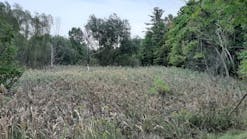Pipe Crews Keep Dry While Working in River
Fishermen along the banks of the New River near Radford, VA, in September 1998 would have seen workers literally in the river. They weren’t divers, although they were working below the water’s surface. In fact, they were working directly on the riverbed but not getting wet. These workers were completing the Town of Christiansburg’s $2.4-million sewer-plant project.
“Construction crews diverted the river around a temporary structure while building a 190-foot pipe extension from the river’s bank out into the water,” explains Barry Helms, assistant town manager for the Town of Christiansburg. The completed project doubled the town’s wastewater diffusion ability.
“The project’s completion upgraded our sewer plant from 3 million gallons a day to 4 million,” says Helms. “The new pipeline is designed for 8 million gallons, but we’re not using its full capacity. The additional 4 million gallons will be available when we need them and prevent us from undertaking such a large project again.”
Christiansburg planners knew they had to increase the outflow of their existing sewer plant. The wastewater, however, was being pumped into Crab Creek, accounting for 80% of the flow into the creek. Therefore, they couldn’t expand the sewer plant and continue to discharge the wastewater into such a small stream. They decided to move the discharge line to the New River, over 20,000 ft. away from the facility.
“More than 3 miles of pipe had to be laid from the sewer plant to the new outfall site,” explains Helms. “In the process, a pump station was built because gravity wouldn’t move the wastewater to the new site.”
Seventeen diffusers were included in the outfall pipe, with room for 17 more. “With this new outfall, we can handle the load,” says Helms. “In the future, divers can go down and open the other caps for more discharge capacity.”
In all, the project involved building the pumping station with three inline 12-in. pumps and over 20,000 ft. of 24-in. ductile-iron pipe, which terminated with 190 ft. of outfall pipe placed out into the New River.
Working in the River
“The river bottom was solid rock,” notes Tommy Johnson, general superintendent of Archdale, NC-based Bryant Electric Company Inc., the general contractor. “Since you can only drive sheet piling until you get refusal, we weren’t able to use it here because of the bedrock.”
The diffuser portion of the project had to be installed several feet below the riverbed. Therefore, Bryant Electric had to choose the safest and most effective method of cofferdamming. A Portadam system, manufactured by Portadam Inc. of Williamstown, NJ, was chosen as the safest and most cost-effective method. The Portadam system uses a lightweight, freestanding design that eliminates the need for costly sheet piling and heavy floating equipment.
Johnson had used this type of cofferdam before, especially for deep and swift water like the New River. “If we didn’t use this system, we would have had to build a rock foundation around the entire work area,” he explains. “Then we would have placed some kind of plastic around the foundation and filled it with dirt.” Building a rock-and-dirt wall, he adds, would have taken at least two weeks.
Portadam Inc. constructed the temporary cofferdam in four days by assembling the structural steel framework in the river. The three-sided structure with access directly from the riverbank was then covered with a continuous vinyl liner, which extended onto the riverbed and formed a sealing apron. No excavation, blasting, fill material, or riverbed alterations were required. The freestanding structure eliminated any cross-bracing, which could interfere with construction of the pipeline, and allowed excavation to be done directly on the riverbed.
Creating a Safe, Dry Work Area
“After the liner was installed on the framework, the water in the interior was pumped out, creating a dry work area directly on the riverbed,” Johnson describes. “We began pumping with two 12-inch pumps. After most of the water was removed, we switched to one 4-inch pump. It took only 12 hours to get rid of all the water.”
As soon as the riverbed was exposed and dry, Bryant Electric crews drilled, shot, and excavated the rock for a trench. They then poured concrete and installed the diffuser pipeline. The cofferdam permitted easy pipe assembly in the bottom of the river, just as if it were being assembled on dry land. The construction engineer and inspectors could walk to the site to see the work being done.
Once the cofferdam was installed and the interior area dry, the job of laying the pipeline and installing the diffuser took two weeks. During this time, Johnson and the crew had complete confidence in the cofferdam’s wall.
“Without the cofferdam, it would’ve taken much longer to complete the project, especially due to the size of the work area we needed,” observes Johnson. “The interior work area was 210 feet long by 35 feet wide and was virtually dry. If we used the other method, it would have taken much longer to build and would have been more difficult to dewater.” The entire pipe extension project took one month to complete.When a project using a cofferdam of any type is finished, the entire dam must be dismantled and removed. If a rock wall is used, all of the rock and dirt must be taken out of the river. At New River, Portadam Inc. removed the temporary structure once the project was complete. “Basically, they take it out of the river in reverse of how they put it in,” says Johnson. All of the structure’s components are reusable.
Cleaner Water During and After the Project
“The department of environmental control was very pleased with the project,” remarks Johnson. “I’ve used this cofferdam system on other projects, and they’re familiar with it.”
The Portadam system produces no siltation or turbidity because no erodible materials are introduced into the water. No in-water excavation is required, and no fill-and-removal process is carried out. There is also no need for disposal of wet materials because none is produced. Once the structure is installed, all work processes are carried out inside a protected area, greatly reducing risk of contaminating the water.
When the project was completed, Christiansburg stopped dumping wastewater into Crab Creek. Although Crab Creek was cited on the state’s dirty-water list, Helms states that tests show the creek is cleaner at and past the town’s sewer plant. The same is true for the New River site. Wastewater released into the river is already cleaner than most areas of the river.
“Besides increasing our town’s ability to diffuse waste by twice what we previously could,” says Helms, “we’ve improved the quality of both the river and the creek.”





